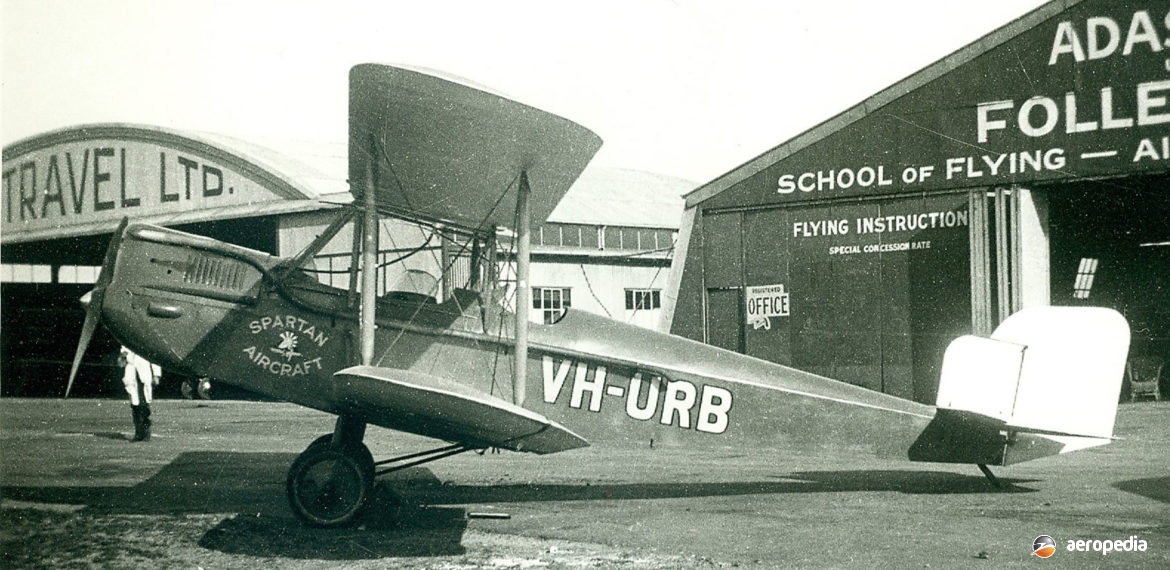Photograph:
Spartan Three-Seater VH-URB (c/n 63) at Mascot, NSW in 1932 (Frank Walters Collection)
Country of origin:
United Kingdom
Description:
Light touring biplane
Power Plant:
(Three-Seater – Mk II)
One 97 kw (130 hp) Cirrus Hermes IV four-cylinder, in-line, air-cooled engine
Specifications:
- Wingspan: 8.8 m (28 ft 10 in)
- Width with wings folded: 2.98 m (9 ft 8 in)
- Length: 8.01 m (26 ft 3 in)
- Height: 2.98 m (9 ft 8 in)
- Wing area: 22.29 m² (240 sq ft)
- Max speed: 172 km/h (107 mph)
- Cruising speed: 153 km/h (95 mph)
- Initial rate of climb: 229 m/min (750 ft/min)
- Ceiling: 4,572 m (15,000 ft)
- Range: 418 km (260 miles)
- Empty weight: 522 kg (1,150 lb)
- Useful load: 231 kg (510 lb)
- Loaded weight: 839 kg (1,850 lb)
History:
Produced as a successor to the Simmonds Spartan, between 1930 and 1935 Spartan Aircraft Ltd constructed a total of 26 examples of its Three-Seater, the first two being completed at Southampton, and the remainder at the Company’s new facility at East Cowes on the Isle of Wight. These aircraft comprised 19 Mk Is and the remainder Mk IIs, this latter model being introduced during 1932 and differing in that the seating was reversed, ie in lieu of the pilot being in the rear cockpit and the two passengers in the front, the pilot was in the front cockpit and the passengers in the rear, this making it more convenient during joy-riding for passengers to obtain access, and making it easier for the pilot to see.
Five of the Mk Is had the 90 kw (120 hp) Gipsy II engine but the remainder had the Cirrus Hermes IIB 86 kw (115 hp) inverted engine, whilst the six Mk IIs had the more powerful 90 kw (120 hp) Hermes IV engine. Both models were of conventional all-wood construction with a plywood covered fuselage and fabric covered mainplanes and tail surfaces. In the United Kingdom the type was usually used for joy-riding on the East and South coasts. Others saw service with Airwork Ltd in Iraq, and a number came to this region. Most had been retired by 1939.
Examples seen in this region included a Mk II VH-URB (c/n 63) first registered on 20 April 1932 to the importer, Robert Bryce & Co Pty Ltd of Melbourne, VIC. On 8 June 1933 it was sold to J J Thorpe of Armadale, WA, and ownership was transferred on 11 August 1934 to James Taxi Planes Ltd of Perth, WA. It then saw service from 3 October 1935 with Airlines (WA) Ltd of Perth as Miss Leonora, but crashed near Mundaring Weir, WA on 16 October 1938.
A second machine VH-UUU (c/n 56 – ex G-ABJS) was a Mk I registered on 20 July 1935 to Mr E G Clerk who traded as Austral Air Services Pty Ltd of Toowoomba, QLD. However, it was destroyed by strong winds at Tennant Creek, NT on 17 January 1936.
An example was imported to New Zealand. This machine (c/n 102) is the sole surviving example of the Three-Seater Mk II, having been built at Cowes on the Isle of Wight in June 1932. It became G-ABYN and was operated by E G Croskin of Hedon Hull, three years later being sold to A Clarke in Clough Jordan in Ireland as EI-ABU. It was stored for many years until obtained by a British restorer who commenced its rebuild in 1971. In 1994 it was shipped to the Croydon Aircraft Co at Mandeville, NZ where work proceeded, eventually being completed by South Air Aviation at Taieri near Dunedin. It first flew again at Taieri on 5 August 2005 as ZK-ARH, being registered on 25 July, and is fitted with a 90 kw (120 hp) Cirrus Hermes IV engine.

